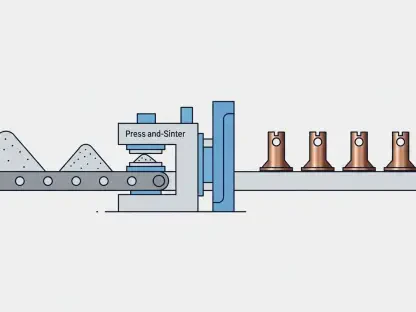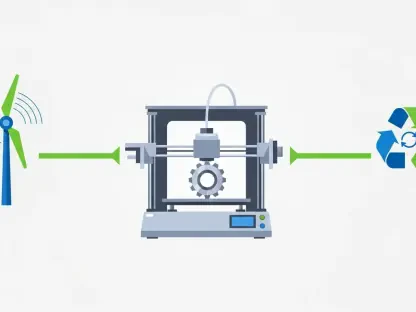In a world where geopolitical tensions, trade tariffs, and supply chain disruptions have become the norm, the U.S. textile industry is undergoing a remarkable transformation that could reshape global markets. Far from being mere victims of circumstance, several major players in this sector are turning challenges into stepping stones for innovation and growth. These companies are not just adapting to a shifting landscape but actively redefining how supply chains operate on a worldwide scale. With a focus on diversification, technological advancements, and strategic partnerships, they are carving out a new path that prioritizes resilience and efficiency. This quiet revolution signals a pivotal moment for the industry, as firms leverage current market dynamics to position themselves as leaders in a competitive arena. The strategies employed by these textile giants offer a glimpse into a future where adaptability is the key to dominance, setting a precedent for others to follow in navigating complex global trade environments.
Strategic Shifts in Manufacturing Hubs
The overreliance on a single manufacturing hub, particularly China, has long posed risks for the U.S. textile industry, amplified by recent tariffs and supply chain volatility. To counter this, major companies are diversifying their sourcing and production bases across multiple regions, significantly reducing exposure to regional disruptions. This strategic pivot involves forging partnerships in countries with favorable trade agreements and lower operational costs, ensuring stability in the face of geopolitical uncertainties. By spreading their manufacturing footprint across dozens of nations, these firms mitigate the impact of localized issues such as labor strikes or policy changes. This approach not only safeguards against potential losses but also aligns with growing consumer demand for transparency in sourcing. The move away from centralized production is a calculated effort to build a more robust framework that can withstand global economic fluctuations, positioning these companies as agile contenders in an unpredictable market.
Another dimension of this shift is the emphasis on localized production, particularly within the United States, to capitalize on the “Made in the USA” label. This trend is driven by both consumer preference for domestically produced goods and the need to bypass international trade barriers. Companies are investing in domestic facilities and licensing agreements that enable them to produce closer to their primary markets, thereby cutting down on logistics costs and delivery times. This strategy also enhances brand perception by associating products with ethical manufacturing practices, a factor increasingly influencing purchasing decisions. Furthermore, localized production offers greater control over quality and supply timelines, reducing dependency on overseas delays. As a result, these textile giants are not only responding to immediate challenges but also building a foundation for long-term sustainability. This dual focus on diversification and localization underscores a broader commitment to reimagining how global supply networks function in today’s economy.
Innovation as a Competitive Edge
Technological innovation is at the heart of how U.S. textile giants are reshaping their supply chains, with a particular focus on efficiency and waste reduction. Advanced tools like AI-driven analytics are being employed to forecast demand and optimize inventory, ensuring that production aligns closely with market needs. This minimizes overproduction, cuts costs, and enhances profitability in a sector often plagued by thin margins. Additionally, automation in manufacturing processes is streamlining operations, allowing for faster turnaround times without compromising on quality. These technological advancements are not mere upgrades but transformative forces that enable companies to stay ahead of competitors still reliant on outdated systems. By integrating cutting-edge solutions, these firms are setting new standards for operational excellence, proving that innovation is a critical driver of success in navigating the complexities of global trade.
Beyond technology, innovation extends to product development and sustainability initiatives that resonate with modern consumer values. Many companies are investing in eco-friendly materials and processes, such as the use of sustainable fibers, to appeal to environmentally conscious buyers. This commitment goes hand in hand with vertical integration strategies, where firms control everything from raw material sourcing to final production, shielding them from external disruptions. Such integration allows for rapid adaptation to market trends and tariff impacts through strategic pricing adjustments. The focus on sustainability and self-reliance is not just a response to current pressures but a proactive step toward future-proofing operations. As these textile leaders pioneer new approaches to production and supply management, they are redefining industry benchmarks. This blend of technological and ethical innovation illustrates a comprehensive effort to build supply chains that are both resilient and responsive to global demands.
Financial Discipline and Market Opportunities
A hallmark of the current transformation in the U.S. textile sector is the rigorous financial discipline displayed by leading firms, ensuring they remain attractive to investors. Strategies such as debt reduction and cost optimization are being prioritized to achieve significant annual savings over the coming years, with targets set for substantial returns by 2028. These efforts are complemented by operational streamlining, which focuses on eliminating inefficiencies across the supply chain. By maintaining manageable debt levels relative to free cash flow, these companies demonstrate financial stability that appeals to long-term stakeholders. This disciplined approach is not merely about survival but about positioning for growth in a market where undervaluation of stocks presents unique opportunities. Investors are thus encouraged to consider the potential upside as these firms continue to strengthen their financial foundations.
Equally important is the recognition of current market dynamics as a window for investment in undervalued textile giants. With stock prices trading at significant discounts compared to their intrinsic value, there is a compelling case for early action. This undervaluation does not reflect the strategic agility and long-term potential of these companies, which are actively reshaping their operations for dominance. Analysts project robust earnings growth driven by pricing power and cost controls, further enhancing the appeal of these stocks. The combination of financial prudence and innovative supply chain strategies creates a rare alignment of risk and reward. As these firms continue to adapt and lead in a reshaped industry landscape, the opportunity to invest in their growth story becomes increasingly time-sensitive. This financial narrative underscores how strategic repositioning is not just about operational success but also about creating value for shareholders.
Building a Resilient Future
Looking back, the journey of U.S. textile giants through a landscape of tariffs and disruptions revealed a remarkable capacity for adaptation and foresight. Their proactive measures—ranging from diversifying sourcing to embracing technological innovation—set a powerful example for industries worldwide. These companies demonstrated that challenges could be reframed as catalysts for reinvention, fundamentally altering how global supply chains were structured. Their focus on localized production and sustainable practices also reflected a deep understanding of evolving consumer expectations, ensuring relevance in a competitive market. The financial discipline they exhibited further solidified their standing as leaders, turning potential setbacks into stepping stones for growth. As a result, the industry witnessed a shift toward resilience that redefined operational norms.
Moving forward, the emphasis should be on sustaining this momentum through continued investment in technology and strategic partnerships. Exploring further regional diversification can help mitigate emerging risks, while deepening commitments to sustainability will strengthen brand loyalty. Policymakers and industry stakeholders might consider supporting these efforts with incentives for domestic manufacturing, fostering an environment conducive to innovation. For investors, staying attuned to the evolving strategies of these textile leaders remains crucial, as their undervalued status may not persist indefinitely. The path ahead involves a collective effort to build on the foundations laid, ensuring that the supply chain transformations initiated today pave the way for a more stable and prosperous tomorrow. This ongoing evolution promises to keep the U.S. textile industry at the forefront of global trade dynamics.









